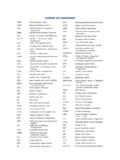Transcription of Pocket Guide to Sagebrush - Sagebrush Steppe Treatment ...
1 Pocket Guide to SagebrushPRBO Conservation ScienceGeneralized map of the primary distribution of Sagebrush in the American West (map courtesy of Laura Quattrini, Rocky Mountain Bird Observatory) Pocket Guide to SagebrushLeila ShultzIllustrations by Linda Ann VorobikDesign and layout by Scott GillihanCopyright 2012 by PRBO Conservation ScienceAcknowledgmentsThis Pocket Guide was made possible by staffs of the Natural Resources Conservation Service (NRCS), USDA Forest Service, Bureau of Land Management (BLM), and Point Reyes Bird Observatory (PRBO) Conservation Science. Special thanks to Wendell Gilgert (without whom this Guide would not have been done), Pat Shaver, Al Winward, Shane Green, Marcus Miller, Durant McArthur, David Tart, John McReynolds, Richard Miller, Brock Benson, Roger Rosentreter, Tim Lowrey, Walter Fertig, and Matt Lavin for direct contributions to the final document.
2 The illustrations by Linda Ann Vorobik ( ) are used with permission of the author and the American Society of Plant College of Natural Resources and the Intermountain Herbarium of Utah State University provided valuable resources to the author (who takes full responsibility for any errors). Specimen documentation for the maps came from dozens of herbaria, referenced in Systematic Botany Monographs vol. 89 (2009). Photos are by the author with the exception of those for Artemisia californica (from Cal Flora database), A. nesiotica (by Joel Martin), and A. rigida (Dave Powell, USDA Forest Service).Maps, layout, and production by Scott W. Gillihan, author of Rocky Mountain Bird Observatory s Pocket Guide to Prairie to Use the GuideThis Guide is written for anyone interested in learning more about Sagebrush species and habitats.
3 The introduction provides descriptions of some of the remarkably diverse Sagebrush Sagebrush communities in western North America. The purpose of the Guide is to give identifying characteristics and range maps for 18 species of Sagebrush , encompassing 27 different kinds (including subspecies and hybrids). More detailed information can be obtained from the taxonomic and ecological treatises mentioned, and it is our hope that this Guide will stimulate further examination of species and their at the back of the book provide a list of names in common use, with citations and synonyms. Taxonomy follows the recent Treatment for the Flora of North America (Shultz 2006) and a monograph of Sagebrush (Shultz 2009).IntroductionSagebrush dominates much of western North America, with approximately 165 million acres of potential habitat.
4 It is the gray sea or Sagebrush ocean familiar to all who travel in western North America. In spite of its prevalence, it is considered a fragile ecosystem that is under siege from a combination of forces. Estimates of habitat loss vary widely depending on region, but since settlement by Europeans, at least half of the area once covered by Sagebrush has been Steppe is prized for its diversity of flowering plants, shrubs, and associated grasses. It grows where there is little rain, winters are harsh, and trees are restricted to streams or protected mountain slopes. Sagebrush provides critically important habitat for a number of wildlife species as well as domestic animals. It provides rangeland for cattle and sheep in areas where they co-exist with endemic wildlife such as the iconic greater sage-grouse, sage thrasher, sage sparrow, and pygmy rabbits.
5 Large animals such as mule deer, Rocky Mountain elk, moose, black bear, pronghorn, mountain lions, coyotes, and gray wolves also share the broad expanses of Sagebrush Steppe with human different kinds of Sagebrush are identified in this Guide primarily through pictures and dialogue. The description of communities is intended to give a brief overview of the habitat diversity within the Sagebrush ecosystem and the diagram on the last page in combination with maps shows where you might find the species in the landscape. For those interested in delving further, an internet search on Artemisia or Sagebrush reveals an astonishing number of published reports on medicinal, managerial, genetic, and ecological species go by several different names, often with the shorthand of sage (which is applied to the genus Salvia in the Mint family as well as Artemisia of the Sunflower family) or wormwood, which includes the herbaceous species of Artemisia.
6 Five species usually classified as herbaceous have been added here because they are woody at the base and, for 4identification purposes, look like Sagebrush . These species are Fringed sage, Fuzzy sage, Birdfoot sage, Porter s sage, and Bud Sagebrush (Artemisia frigida, A. papposa, A. pedatifida, A. porteri, and A. spinescens). Interested readers can find more in the literature, and the selected references and websites will serve as a beginning Guide . To navigate the different plant names, the appendix at the end of this book provides a cross-reference to scientific names as well as common Changing LandscapeThe recent increase in severe droughts has affected the health of native grasses. While Sagebrush is amazingly resilient to climatic extremes, the shrublands are being replaced by exotic annual grasses and other invasive species after disturbances such as wildfire.
7 As a consequence of these changes, the Western Association of Fish and Wildlife Agencies has called for new conservation measures to increase the resiliency of the Sagebrush Steppe habitats and sage grouse populations they support. Land managers are being called on to monitor Sagebrush Steppe habitats and implement programs to minimize impacts and manage the risks to humans and other of how much Sagebrush Steppe remains depend on the geographic region. Loss of habitat appears to be accelerating, especially with the changes following wildfire or urban expansion, and an estimated 50% of Sagebrush habitat has been lost in the Great Basin in the past 50 years. In California, recent reports suggest that as much as 90% of coastal Sagebrush scrub has 5been lost. Even so, with millions of acres remaining, the common Big Sagebrush is not in danger of extinction, but there is growing concern about the fragmentation of habitat and loss of migration routes and feeding grounds for wildlife.
8 A few of the Sagebrush species treated in this book are very limited in geographic range. They, and the changing boundaries (both expanding and shrinking) of some of the more widespread species, may be useful in monitoring ecological BiologySagebrush species belong to the Sunflower family, or Asteraceae. They do not have the showy flowers that are common to most members of this family. Rather than depending on insect pollination under cold desert condition, Sagebrush depends on wind for pollination. It produces massive amounts of pollen in the late summer and early fall. The flowers are tiny but abundant: hundreds of flower heads are on a single flowering stem of big Sagebrush , and each flowering head has between two and ten florets. Each flower produces only one microscopic seed (about 1 mm in length), but each plant potentially produces many thousands of seeds.
9 Flowers mature in late summer (except for early low Sagebrush ) and seeds mature in the fall. The seeds disperse after they pass through animals that eat the seed heads, or by winds that blow across the snow crusts that are littered with the tiny seeds during winter of the Sagebrush species are evergreen, but a few are deciduous, and some are just plain opportunistic keeping 6leaves on in a wet year but dropping them when it gets dry. Early spring is when the leaves are most bitter (and the characteristic Sagebrush odor is strongest) a strategy that works to reduce insect predation and grazing by wildlife when the plants are coming into flower. As fall and flowering season approach, the bitter terpenes, camphors, and other secondary compounds start to break down and the seed heads become more palatable.
10 Seeds have approximately 20% protein content and the seed heads provide an important winter food for wildlife as well as some domestic animals. Sage grouse species are among the few animals that rely almost exclusively on Sagebrush foliage as a food source throughout the identification purposes, it is important to know that there are two kinds of leaves produced on the evergreen species. Big Sagebrush (Artemisia tridentata and its subspecies) is the most widespread and abundant of all the species. It produces early spring leaves that expand rapidly and are sometimes irregular in shape exposing a large surface area to capture as much sunlight as possible, like a sucker shoot on a tree. These leaves tend to yellow and drop by mid-summer and they should be ignored for measurement purposes. The leaf lengths given in the descriptions are for the perennial leaves.






